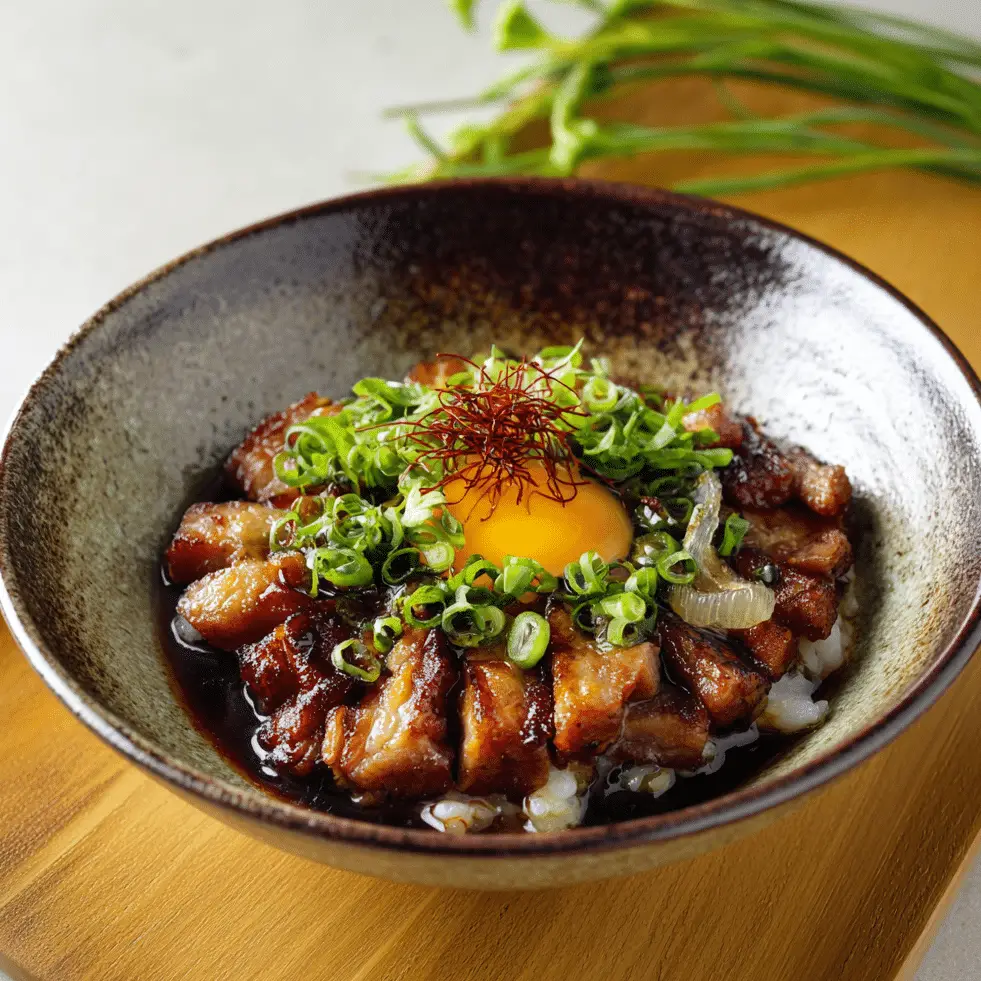Transport your taste buds to Hokkaido’s Tokachi region with this Obihiro‑style butadon—a soul‑warming pork bowl where tender pork enveloped in a caramel‑rich sauce melds beautifully with steamed Japanese rice. Caramelization of aromatics and sugar in the sauce adds that crave‑worthy umami depth that makes every spoonful irresistible.
Despite its gourmet allure, this dish is effortlessly simple: sear, simmer, and serve. Perfect for a cozy weeknight dinner or an impressive weekend treat, it’s versatile enough to garnish with pickled ginger, green onions, or a dash of shichimi for your desired brightness and zing.
Full Recipe
Ingredients:
-
500 g thin‑sliced pork belly or loin
-
1 medium onion, thinly sliced
-
2 Tbsp sake
-
3 Tbsp mirin
-
3 Tbsp soy sauce
-
2 Tbsp sugar (cane or brown)
-
½ cup dashi stock (or water + ½ tsp dashi powder)
-
1 tsp grated ginger
-
1 Tbsp vegetable oil
-
2 cups steamed Japanese short‑grain rice
-
Optional garnish: pickled ginger, green onions, shichimi togarashi
Directions:
-
In a bowl, mix sake, mirin, soy sauce, sugar, dashi stock, and ginger; set aside.
-
Heat oil in a skillet on medium‑high. Sear pork slices until lightly browned on both sides; remove and drain fat.
-
Lower heat to medium, add onion and sauté until translucent.
-
Return pork to skillet, pour in sauce mixture, bring to a gentle boil.
-
Simmer, stirring occasionally, until sauce reduces slightly and coats pork, ~10–15 min.
-
Taste and adjust seasoning—add a splash of water if too salty, or simmer longer if too thin.
-
Serve hot pork and sauce over bowls of rice. Top with pickled ginger, sliced green onions, and a sprinkle of shichimi if desired.
Prep Time: 10 min | Cooking Time: 25 min | Total Time: 35 min
Kcal: approx. 650 kcal per serving | Servings: 4
Introduction to Butadon: A Japanese Comfort Classic
Butadon, literally translating to “pork bowl,” is a beloved Japanese dish that originates from the city of Obihiro in Hokkaido. Known for its simple preparation and rich flavor, Butadon features tender slices of pork, typically belly or loin, simmered in a sweet and savory sauce made from soy sauce, sugar, mirin, sake, and dashi. The glossy, caramelized pork is then served over a bed of freshly steamed Japanese rice, often topped with optional garnishes such as green onions, pickled ginger, or shichimi togarashi.
What makes Butadon so unique is its balance between hearty satisfaction and clean, comforting flavors. It exemplifies the spirit of Japanese home cooking — unfussy, efficient, and deeply rooted in regional tradition. Whether served as a weekday dinner or a quick lunch, this dish is sure to bring a sense of warmth and nostalgia.
The Origins of Butadon
Butadon hails from Obihiro, a city situated in the Tokachi subprefecture of Hokkaido, Japan’s northernmost island. Tokachi is known for its fertile farmlands, rich dairy products, and quality livestock, making it the perfect birthplace for a dish centered on high-quality pork. Butadon was originally created as a hearty, affordable meal for local workers and farmers, giving them the sustenance they needed to power through long days in the fields.
The simplicity of Butadon allowed it to spread quickly, becoming a staple of Obihiro’s local cuisine and eventually appearing in restaurants and homes throughout Japan. While there are slight regional variations, the essence of Butadon remains the same: juicy pork slices simmered in a fragrant sauce and paired with the pure, fluffy texture of Japanese short-grain rice.
Why Butadon Stands Out
The beauty of Butadon lies in its minimalist ingredient list and the technique that extracts maximum flavor from it. The combination of soy sauce and sugar brings that characteristic sweet-and-salty Japanese flavor, while mirin and sake round out the profile with umami depth and mild acidity. When simmered together with dashi — a broth made from kombu and bonito flakes — these ingredients transform into a sauce that’s deeply savory yet delightfully light.
Unlike grilled or deep-fried pork dishes, Butadon is simmered, allowing the pork to absorb all the nuances of the sauce while remaining juicy and tender. The onions in the recipe caramelize slightly during the cooking process, adding another layer of sweetness and texture.
The Role of Rice in Butadon
Rice plays more than just a supporting role in Butadon. Japanese short-grain rice is known for its sticky, chewy texture that contrasts beautifully with the soft pork and silky sauce. The rice absorbs some of the sauce, soaking up the umami richness while retaining its own subtle sweetness. It’s this synergy that makes Butadon such a comforting and filling meal.
Quality rice is essential to achieving the true taste of this dish. Many Japanese households rinse their rice multiple times before cooking to remove excess starch and then allow it to soak for 30 minutes to ensure the perfect texture. Whether prepared in a rice cooker or on the stovetop, perfectly steamed rice can elevate the entire dining experience.
Modern Takes and Regional Variations
Although the original Obihiro version of Butadon remains the most iconic, modern adaptations of the dish have popped up across Japan and beyond. Some versions include a fried egg on top, a drizzle of spicy mayo, or even a handful of chopped herbs for freshness. Others substitute the pork belly for leaner cuts or use chicken for a lighter version.
Vegetarians have also started crafting Butadon-inspired bowls using tofu or mushrooms as the protein base while retaining the same addictive sauce. These modern interpretations prove just how versatile and appealing Butadon can be to a global audience.
In restaurants across Japan, Butadon is often served as a set meal, accompanied by miso soup, pickles, and a small side salad. This balanced presentation transforms what might seem like a humble pork bowl into a complete, nutritionally satisfying meal.
Tips for the Perfect Butadon at Home
If you’re making Butadon at home, a few simple techniques can make a big difference:
-
Thinly slice the pork: This ensures that it cooks quickly and evenly, soaking up the sauce in every bite.
-
Don’t skip the onions: They add a natural sweetness and absorb flavor like a sponge.
-
Simmer gently: A low, slow simmer prevents the sauce from burning and helps it cling to the pork.
-
Garnish mindfully: Pickled ginger cuts through the richness, while green onions add a burst of freshness and color.
Some cooks like to prepare a large batch of the pork and sauce ahead of time and simply reheat it over rice when needed. This makes Butadon an excellent choice for meal prepping or for serving a family dinner on a busy weeknight.
Health Considerations and Nutritional Value
While Butadon is rich and satisfying, it can also be part of a balanced diet. Pork belly, while higher in fat, provides protein and essential nutrients such as thiamine, zinc, and vitamin B12. If you’re looking for a leaner option, pork loin is an excellent substitute.
The sauce ingredients — soy sauce, sugar, and mirin — can be adjusted to suit dietary preferences. Low-sodium soy sauce or tamari can reduce salt content, and natural sweeteners such as honey or coconut sugar can be used in place of refined sugar.
To make Butadon even more nutritious, consider adding steamed or stir-fried vegetables on the side. Bok choy, spinach, or broccoli all pair beautifully with the sweet-savory profile of the dish.
Cultural Significance in Japanese Cuisine
Butadon is more than just a meal — it’s a window into Japanese culinary philosophy. Like many traditional dishes, it reflects the principles of balance, seasonality, and respect for ingredients. Its rise from humble worker fare to a nationally cherished dish also highlights the ingenuity of Japanese home cooking.
This dish also embodies “gohan no okazu” — the concept of dishes meant to accompany rice. In Japan, rice is not just a side; it’s the heart of the meal, and everything else revolves around it. Butadon, with its flavorful sauce and tender meat, exemplifies this relationship perfectly.
Conclusion: Why You Should Try Butadon
Butadon is a dish that comforts the soul and satisfies the stomach. It’s incredibly easy to prepare, yet deeply flavorful and rich in cultural heritage. Whether you’re exploring Japanese cuisine for the first time or are a seasoned foodie looking for a new favorite, Butadon deserves a spot in your kitchen rotation.
Its versatility means you can adapt it to your taste or dietary needs, while its core simplicity ensures that anyone can make it with just a few pantry staples. Serve it on a rainy evening, share it at a family gathering, or pack it as a comforting lunch — no matter how or when you enjoy it, Butadon will never disappoint.
By embracing this dish, you’re not just learning a recipe; you’re participating in a culinary tradition that spans generations. Give it a try, and you may find that a humble pork bowl from northern Japan becomes one of your most treasured meals.






